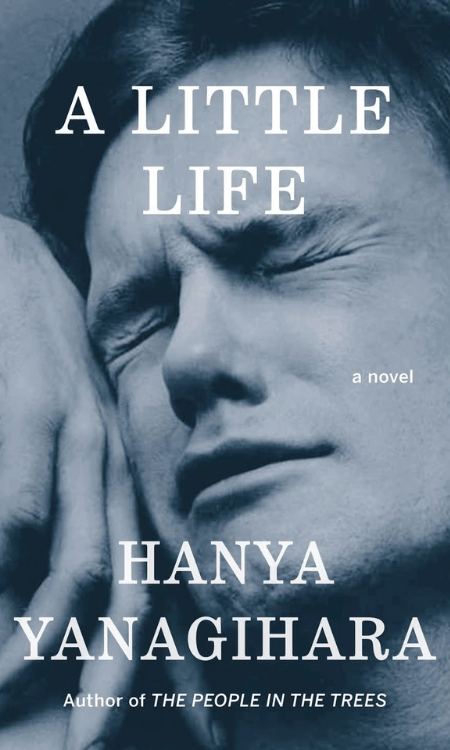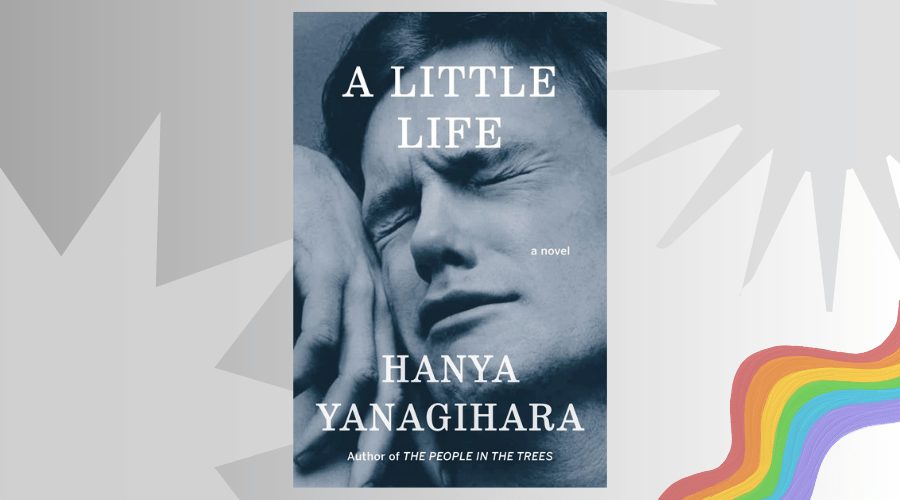A Little Life is a deep, emotional, and complex novel about the lives of four college friends, Jude St. Francis, Willem Ragnarsson, Malcolm Irvine, and JB Marion, as they struggle through adulthood in New York City. It is mostly about Jude, though—the incredibly brilliant but very troubled lawyer who keeps most of his very traumatic and troubled past to himself, even from his best friends.

| ✍️Author | Hanya Yanagihara |
| 📅Publication date | March 10, 2015 |
| ⭐Goodreads Rating | 4.32 |
| ✔️ISBN-10 | 0385539258 |
| 📆 Page count | 720 pages |
| ❔Topics | Fiction, Contemporary, LGBT, Literary Fiction, Queer, Mental Health, Adult, Novels, Adult Fiction |
A Little Life Summary
A Little Life, by Hanya Yanagihara, is a very emotional and complex novel that narrates the story of four college friends—Jude St. Francis, Willem Ragnarsson, Malcolm Irvine, and JB Marion—who move to New York City after graduation in order to pursue their ambitions. The novel starts with the shared lives and changing dynamics of the group but gradually zeroes in on Jude, a brilliant lawyer whose mysterious and traumatic past forms the inner core of the novel.
Jude is portrayed as a deeply complex character, grappling with the enduring effects of unimaginable trauma from his childhood. As his story unfolds, readers learn of the abuse and exploitation he suffered, leaving him with both physical disabilities and emotional scars that persist into adulthood. Jude’s struggle with self-worth, chronic pain, and self-harm becomes central to the novel. With all his professional success and the unconditional love and support of his best friends, it is almost impossible for Jude to shake off the specter of his past.
The three other characters—Willem, a would-be actor with a gentle and nurturing soul; Malcolm, a well-to-do architect looking for his place in life; and JB, a magnetic yet self-centered artist—all assume vital roles in Jude’s life. Their friendship is deep, but they also go through troubles and strains, especially as Jude’s struggles tend to push their relationships to the edge. In particular, Willem becomes Jude’s closest confidant, and later his partner, offering moments of comfort and unconditional love, even as Jude remains very much captive to his own suffering.
Unflinching in its exploration of themes such as friendship, love, trauma, resilience, and the search for meaning in the face of profound pain, Yanagihara weaves these elements together with masterful skill. She uses non-linear narration, interspersed with striking prose that describes the beauty and anguish of human experience. The reader, through flashbacks and present-day events, becomes privy to Jude’s inner world and the ways in which his past acts on his relationships and sense of self.
While often described as heartbreaking and emotionally intense, it really points to the power of love and connection. The novel puts readers to the test of reflecting on what suffering is, the complexity of healing, and ways in which people can be supported through life’s darkest moments. The raw, evocative writing and deep characterization make it such a moving read likely to leave a long-lasting impression.
At over 700 pages, this is no small commitment of time and effort; yet for those willing to engage with its beautifully crafted, emotionally charged world, A Little Life affords an unforgettable exploration of the fragility and resilience that is the human spirit.
How Does A Little Life End?
After years of fighting against his physical pain, emotional scars, and mental state, Jude reaches the point where his trauma and despair turn out to be too much for him to handle. Despite being loved and surrounded by friends who truly care, especially Harold, his adoptive father figure, Jude takes his life.
This decision is foreshadowed throughout the book, as Jude continually struggles to reconcile his past with his present. Even though he experiences moments of love and connection, particularly with Willem, the weight of his trauma remains overwhelming. The death of Willem, earlier in the novel, devastated Jude and took away one of his strongest sources of comfort and stability.
The book ends with Harold reflecting upon Jude’s life and legacy. Harold is heartbroken for Jude, but he also rejoices in how much Jude had affected the people in his life despite all that suffering. The ending has emphasized some of the main themes of the novel: lasting traumas, love and friendship in all their complicated forms, and the limits of human resilience.
The ending is sad yet poignantly powerful, leaving the readers with a feeling of deep loss but also an acknowledgment of the beauty and fragility of life.
A Little Life Characters
Here’s a quick rundown of who’s who in the main cast of A Little Life:
- Jude St. Francis: The central character, Jude is an extremely brilliant lawyer with a traumatic and mysterious past. He bears physical and emotional scars from massive abuse he suffered as a child. His friendship with his pals means everything to him, yet his past catches up with him all the time.
- Willem Ragnarsson: Best friend of Jude, and later his lover. Willem is an aspiring actor who, throughout the novel, becomes a great success. He is compassionate, loyal, and very important in Jude’s life, offering love and support through Jude’s various struggles.
- Malcolm Irvine: An architect, another good friend of Jude’s from college. Malcolm is from a rich family. He is always at odds with his family over expectations that are placed upon him by them and what he wants. His life’s core is built around his friendship with Jude, Willem, and JB.
- JB Marion: A charismatic artist and the most outgoing of the group, JB is ambitious, yet he wrestles with his own demons, like addiction. His friendship with Jude becomes strained at times, but he remains an important figure in Jude’s life.
- Harold Stein: A professor of law who becomes a father figure to Jude. Eventually, Harold and his wife, Julia, adopt Jude, giving him a sense of family and belonging he never experienced before.
- Andy Contractor: A doctor and the confidant of Jude, very much concerned by the state—both physical and mental—of Jude. He tries hard to take care of him, and Jude, in so many ways, resists.
A Little Life Trigger Warning
This novel is a graphic, often disturbing work for some readers. Among some of the very heavy themes dealt with within the book are:
- Child abuse: this includes sexual, physical, and emotional abuse, along with neglect.
- Sexual assault: extremely detailed and recurring depictions of assault, including by trusted figures.
- Self-harm: very graphic descriptions of cutting and other forms of self-injury.
- Suicide: mentions of suicidal ideation and attempts, along with depictions of suicide.
- Chronic pain and disability: Depictions of physical suffering and its emotional toll.
- Addiction: Substance abuse and its impact on relationships and well-being.
- Depression and mental illness: Includes severe PTSD, self-loathing, and emotional trauma.
- Death and grief: Loss of loved ones, with the profound weight of grief.
This novel is well-known for its emotional gut punch and unflinching portrayal of dark themes. It’s recommended that readers go into it with caution and in the right state of mind. Should any of these themes be triggering for you, it may be best to skip this novel or read it with support.
Is A Little Life worth reading?
A Little Life is worth reading, provided one has the stomach for a deeply emotional, intense story. Character development is deep, the writing is beautiful, and it basically explores heavy themes such as trauma and friendship in their own twisted way. However, it’s also very tough with graphic content—so not for everyone. This is a strong, memorable book if you can manage the emotional weight of complex, character-driven novels. But if you’re the type who likes light reads, or dark themes impact you easily, it’s best passed.
What genre is A Little Life?
First of all, A Little Life is literary fiction. It is known for its deep excavation into complicated themes such as trauma, friendship, love, and the human condition. The novel also dips into psychological fiction due to the intensive exploration into the inner lives and emotional experiences of the characters, especially Jude St. Francis.
Is A Little Life a True Story?
No, A Little Life is not a true story. It’s a work of fiction, created completely by the author Hanya Yanagihara. The events and characters in the novel may feel very real due to Yanagihara’s writing and emotional depth, but the story does not follow any real events or people.
In interviews, however, Yanagihara said that she steers clear of the dates and times so that her book can also become timeless and universal. She also applied the observation from human relationships to suffering for developing detailed portrayals of trauma, friendship, and resilience in her book. Thereby, this vividness often attaches the readers emotionally with the storyline, but at the same time, it remains a fictional account of events.
A Little Life Age Rating
A Little Life is generally recommended for mature readers, typically ages 18 and up, due to its intense and graphic content.
When does A Little Life Get Sad?
A Little Life starts to reveal its heavy emotional core relatively early, but it gets progressively more heart-wrenching as the story unfolds. Here’s when and how that happens:
Early Foreshadowing (First 100 Pages)
First introduced in the novel are Jude, Willem, Malcolm, and JB; from the outset, though, it has already been indicated that Jude goes through physical and emotional struggles. Right from his mysterious past and chronic pain, and not being able to state minute details of his life, an undercurrent of sadness can be felt from him.
As the backstory of Jude unravels, the book gets much darker. Flashbacks of the extreme abuse, neglect, and exploitation he experienced as a young person and teenager start to come to light. It shows layers of tragedy to his character and explains his self-destructive tendencies.
Willem and Jude’s Relationship
Moments of tenderness and love, like the eventual romantic partnership between Jude and Willem, are equally bittersweet. Jude can never fully learn to let love in because of his numerous insecurities about self-worth, thereby never truly finding peace even with them.
Key Tragedies (Later Parts)
Sadness has peaks at devastatingly high levels at a few major events:
- Willem’s death from the car accident completely shatters Jude emotionally.
- Jude’s continued downward spiral into self-harm and despair, despite Harold’s efforts to support him.
The Ending
The ending of the novel is probably its saddest moment, as Jude takes his own life after years of battling his trauma and pain. Harold reflects on Jude’s life and legacy with a poignancy that speaks volumes of love, loss, and heartbreak.
📚 Explore more: A Little Life Book Club Questions

